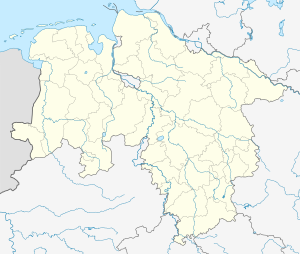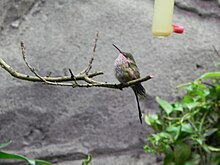Walsrode World Bird Park
| Walsrode World Bird Park | ||
|---|---|---|
| place | Am Vogelpark 29664 Walsrode |
|
| surface | 24 ha | |
| opening | 1962 | |
| Animal species | approx. 650 | |
| Individuals | approx. 4000 | |
| Visitor numbers | 300,000 (2011) | |
| organization | ||
| Sponsorship | Parques Reunidos | |
| Member of | WAZA , EAZA , VdZ , CRAX International, Cracid Breeding and Conservation Center (CBCC) | |
|
Park with typical aviaries and restaurant in the background |
||
| www.weltvogelpark.de | ||
|
|
||
Coordinates: 52 ° 52 ′ 52 ″ N , 9 ° 36 ′ 1 ″ E

The Walsrode World Bird Park is the world's largest bird park . It was opened in 1962 and is located in the Lüneburg Heath in the area of the city of Walsrode in Lower Saxony . Around 4,000 birds from 650 species live on the 24-hectare site , making the park one of the most species-rich zoos in the world. Birds from all continents and climates in the world can be seen.
Investments
The bird park consists of a large number of indoor and outdoor aviaries as well as outdoor enclosures. In addition, in a free flight hall with an attached dune landscape and wave system as well as in several buildings, such as B. the tropical forest house, the opportunity to meet the birds in an imitation of their natural environment without dividing bars. New since the 2011 season is a Lori contact aviary " Toowoomba ", in which the visitor has direct contact with tame Loris . Since the end of 2011 a new Kolibri house has been added. These can be observed in the aviaries specially adapted to the behavior of the hummingbirds . While in the newer areas of the bird park the natural environment of the birds has been reproduced, the older areas largely consist of park and forest landscapes, among others. a. with large beds of roses and rhododendrons .
Flight demonstrations on an open-air stage are a special attraction. Here not only flights of falcons and eagles are shown as in other air shows, but also, among other things, of parrots , pelicans , secretaries and ducks . The program also includes various feeding demonstrations and a baby bird rearing station that can be seen from the outside.
The post mill in the bird park is a station on the Lower Saxony Mill Road .
Breeding programs
The bird park has great international reputation, as he holds the one hand a number of birds that can be seen in any other zoo in the world (eg. As coua , ground roller , Vangawürger and Kurole ), and enter a number of Erstzuchten to others here . The bird park is involved in the European conservation breeding program and has also made eagle owls available for reintroduction. He is also involved in the breeding program of the Bernese Duck and many other endangered bird species. In 2011 a breeding center was built to keep the extremely sensitive hummingbirds, where they are looked after all day and monitored around the clock. Among others live here Grünschwanzsylphe ( Lesbia nuna ) and amazilia hummingbird ( Amazilia amazilia ).
history
The park was founded in 1962 by Fritz Geschke, a businessman from Walsrode, as a private breeding facility for pheasants and water birds . In 1964 he handed the park over to his son-in-law Wolf W. Brehm, who expanded the park rapidly, especially in the 1970s. In 1968 the Paradies-Halle was opened with an area of 2,100 m². Pioneering buildings followed, such as the free flight hall and a penguin enclosure.
In 2000, on the occasion of Expo 2000 in Hanover, the tropical forest hall with Indonesian artefacts and Asian bird species was opened. The UHU castle and the tree house village were added later. The German Vogelbauer Museum, also located in the bird park, was closed in 2006 and the exhibits were auctioned at Sotheby’s .
Due to business difficulties of the previous operators, the park was taken over by new operators in 2000. While show effects were largely dispensed with in earlier years, the new owners have gradually introduced flight demonstrations and other things since 2000, increasing the attractiveness for visitors and ensuring the existence of the park. The number of visitors fell to 280,000 in 2008, 50,000 fewer than were necessary for economic operation. A threatened bankruptcy was averted in March 2009 by the entry of the Belgian company Floralux .
In 2010, the Walsrode bird park was renamed the Walsrode World Bird Park.
At the end of July 2018 it was announced that the bird park would be sold to the Spanish Parques Reunidos Servicios Centrales SA . The Federal Cartel Office approved the takeover on August 7, 2018. The contract was signed at the end of January 2019.
literature
- Weltvogelpark Walsrode Parkguide , Ed .: Vogelpark Walsrode GmbH, 36th edition, 2012, 212 pp.
- Botany in the Weltvogelpark Walsrode - a journey of discovery into the world of plants , Katrin & Alexander Laatsch, BooksOnDemand, 2012, 52 pages, ISBN 978-3-8448-1905-2 .
- We discover the birds (Why? Why? Why?) , Patricia Mennen (author) & Anne Ebert (illustrator), Ravensburger Buchverlag, ISBN 978-3-473-32831-4 .
- We discover the birds (Why? Why? Why?) [Audiobook] (Audio CD) , Jumbo Neue Medien & Verlag GmbH, ISBN 978-3-8337-2620-0 .
- Vogelpark Walsrode - much more than birds , publisher: Vogelpark Walsrode GmbH, o. O. o. J. (31. A.), 162 p. M. numerous Fig.
Web links
Individual evidence
- ↑ www.n-tv.de n-tv.de report on the 50th anniversary of the Walsrode World Bird Park
- ↑ Feathered stars are waiting for your visit. Walsrode World Bird Park website, accessed on January 12, 2019.
- ^ "The bird park Walsrode is saved", Hamburger Abendblatt, March 28, 2009
- ↑ Spanish operator wants Vogelpark Walsrode. In: ndr.de. July 31, 2018, accessed August 2, 2018 .
- ↑ Vogelpark Walsrode sold to Parques Reunidos
- ↑ New botany guide: A journey of discovery into the world of plants ( Memento from April 20, 2012 in the Internet Archive )
- ↑ Book presentation on June 26, 2010 in the bird park: Well researched is half the battle. For the new book “Why? Why? Why? We discover the birds ”, three days ago, author Patricia Mennen and illustrator Anne Ebert from Ravensburger Buchverlag obtained detailed information from the experts at Weltvogelpark Walsrode ...


